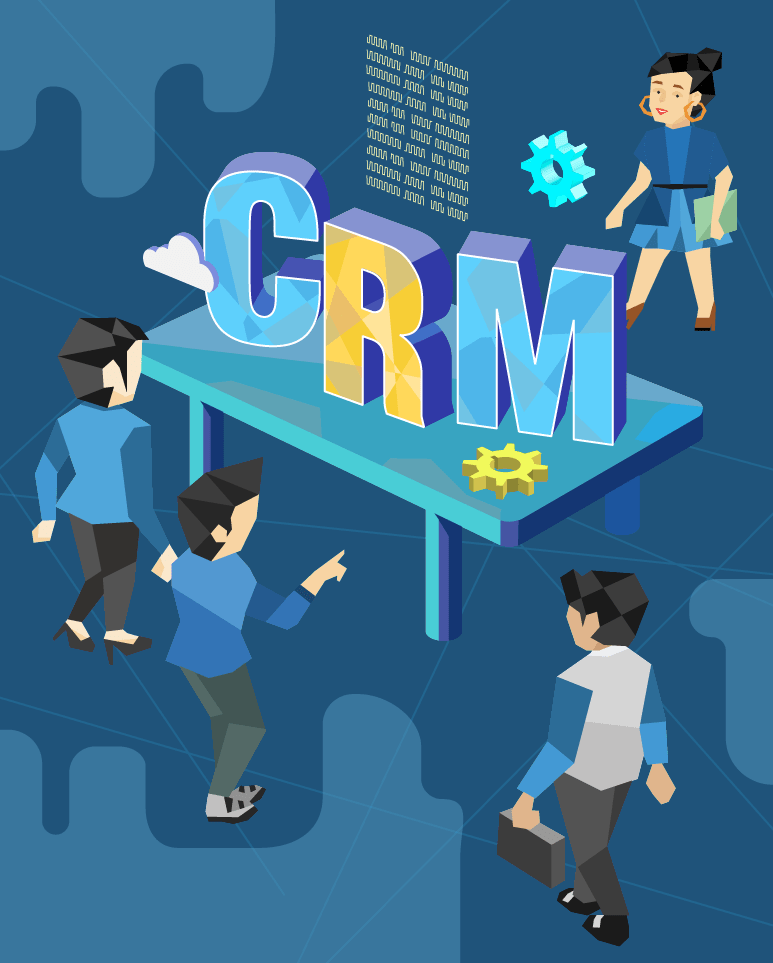Keeping Your Data Clean For Your CRM Strategy

The data your company is constantly collecting and (hopefully) analyzing is one of your organization’s greatest assets. Data is the backbone of your CRM (customer relationship management) strategy. When properly leveraged, data can provide you with actionable insights that can help you improve every facet of your business to make it run more efficiently and effectively. Insights that can significantly increase your company’s ability to grow.
What you may not realize is that the data you’ve collected doesn’t always remain 100 percent accurate. Data can go bad when it becomes outdated. It’s estimated that roughly 30 percent of the data that any given organization collects goes bad every year. Not to mention that up to 25 percent of all databases contain errors that result in inaccurate metrics. This means that over half of your data could be inaccurate! Fortunately, there’s a solution to this issue: cleaning your data.
Why It’s Important To Keep Your Data Clean
Before delving into the process of cleaning your data, we’d like to emphasize how important it is to clean your data. We’ve compiled some of the reasons for maintaining a clean database to prevent your data from becoming outdated and to eliminate any errors it may contain:
- Ensure Data Accuracy – The main reason why databases often contain errors and inconsistencies is that you’re collecting data from multiple sources. This means that if a lead was performing different actions on two different channels, the data collected by those channels on that lead will be different. One channel may also have outdated information from a lead that another channel has more up-to-date information on. This is in addition to manual data entry which businesses rely on their teams to keep up with.
- Enhance Your Reputation – By ensuring that the data you’re using is accurate, you’ll reduce the number of mistakes you make, especially when engaging with leads and customers. The fewer mistakes you make, the stronger your reputation will be.
- Provide Accurate Analysis – The more accurate your data is, the more effective your analysis of that data will be. Analyzing inaccurate data will lead to inaccurate insights. For example, if you’re using personal information customers provided you a decade ago to determine where the majority of your customers live, that data is likely inaccurate now since many customers may have moved to a different location within those ten years. For the results to be accurate, the data needs to be up-to-date.
- Accelerate Your Lead Conversion – The more accurate your data is, the more capable you’ll be of tracking your leads through their buyer’s journey, guiding them more effectively and accelerating your lead conversion.
- Improve Customer Satisfaction – Not having accurate or up-to-date data on a customer can make interactions with them difficult. Ideally, your sales team should be able to pull up customer information in real-time that allows them to address their current needs and problems without having to request the customer to backtrack over their past history. With accurate customer information, you’ll be able to target them with more relevant content and promotional material.
- Improve Forecasting Capabilities – Businesses are relying on their data more and more to discover new trends and to forecast the success of certain marketing and sales tactics and strategies. The more accurate your data is, the more valuable your insights into potential trends will be. The ability to forecast trends and events depends heavily on your data’s accuracy.
- Improve Email Marketing Deliverability – Data helps you determine how effective your email marketing campaign is. Using the most accurate data available allows you to segment your audience more effectively and to create content that is more relevant to their needs, improving the success of your email marketing.
Steps Towards Maintaining a Clean CRM
With an understanding of why cleaning your data is so important and how it can benefit your organization, here is how to begin the data cleaning process.
Use Your CRM’s Built-In Deduplicator
Because you have leads and customers who likely use different channels to engage with your brand, there’s a chance that you’re collecting duplicate information. For example, you may have two profiles of the same customer in your database. Your CRM solution should have a built-in deduplication tool that can comb through your database for duplicate data which can then be merged or removed.
Use Email Validation Tools
Because of the vital part that email plays in any marketing strategy, using email validation tools (also referred to as email verification tools) will help you keep your email list updated. For example, you’ll be able to identify email addresses that do not exist (some leads may use fake email addresses on your forms) or no longer exist so that you can delete them from your email list. You can also remove email addresses from recipients who have ignored your emails.
Not only can you significantly reduce your email bounce rate by keeping your email list up-to-date, but you also won’t waste money sending emails that aren’t going anywhere. It will also improve your email analytics. If a customer hasn’t been opening your emails in years, they should be removed since they are causing your click-through-rate to decline, resulting in inaccurate insight into the quality of your emails. It’s difficult to identify issues with your email marketing efforts (and to figure out how you can improve them) if you’re getting inflated bounce rates and low CTR figures in your analytics due to email addresses that don’t exist or past customers/leads that haven’t engaged in a long time.
Follow A Set Of Rules For Lists, Tags, And Fields
To avoid duplicate data that are organized under different names, establish a set of rules for naming your lists, your tags, and your fields. Making sure all of your data from every data source is consistent and clearly marked will ensure that it’s properly labeled and organized in your CRM, thereby helping to improve its accuracy.
Routinely Purge Or Clear Out Inactive Or Useless Contacts
Just like when you use an email validation tool to remove email addresses that are no longer active or engaged with your brand, clearing out contacts that are inactive or useless from your CRM is equally important. You may have leads who turned out to be dead ends or customers who have moved away (out of the area you serve), no longer need your product or service, or have switched to another brand — to name a few possibilities. Leaving their contact information in your CRM is pointless and can only result in wasted efforts in attempting to engage with them. Routinely purge contacts such as these so that your marketing and sales personnel don’t waste their time on them and so that your analytics aren’t affected by their inactivity.
Run Frequent Re-Engagement Campaigns to Keep Lists Warm
You’ll only want to remove contacts if you know that they are no longer engaged with your brand. The fewer of these contacts you have to remove, the better. It’s why you should run frequent re-engagement campaigns. Running a re-engagement campaign before you purge your contacts also allows you to identify unengaged contacts to see if there’s any point in keeping them in your database.
Specify ‘Fallbacks’ For Any Field Which May Be Used For Personalization
You will have any number of competing data sources for the same data type. The challenge is deciding which source is to be defined as the “true” source. Information, such as contact names, can be used for personalization. There can be multiple data sources for that contact name, such as chat conversations with that contact, an ebook download form, or sales rep input.
Because you have multiple data sources, using a fallback strategy to define the sequence of data sources for any given attribute is a good idea. Doing this ensures that the most accurate, up-to-date data is used. The two main types of fallback strategies include time-based (when you source data) and source-based (what data sources should be prioritized). How you specify fallbacks for any field that could be used for personalization (such as contact names) depends on what data sources you determine to be the most reliable.
Use Unique Identifier Fields to Avoid Duplications
Removing duplicates from your database is important, but taking steps to avoid them altogether will make things much easier in the long run. It can be difficult to avoid duplications when there are multiple lead sources as well as multiple people handling your CRM data. To help avoid duplicates, mark fields as “unique” in a record whose value makes them unique. For example, in a lead’s record, you could mark their email address as the unique identifier field. When you do this, it will prevent your CRM from creating another contact record using the same email address, and prevent a duplicate entry.
Ensure Those Responsible for Data Entry Understand the Expectations
Finally, make sure that everyone who handles data entry within your organization understands how important it is to keep your data clean. They should be trained on the best practices for avoiding data duplication and how to correctly input data to avoid errors. Individual data entry mistakes can be easily eliminated by simply communicating your expectations.
The Age-old Rule Is “Junk In, Junk Out”
Your CRM data can be an incredibly valuable asset when it comes to nurturing leads and engaging with customers. However, its value comes from its accuracy. Inaccurate data is useless and can hurt your marketing, sales, and customer service efforts. It’s very important that you routinely clean your data.
Clean And Accurate Data Is The Foundation for Growth
Taking the extra effort to clean your data and to prevent errors and duplications wherever possible is incredibly important. We call this data hygiene. After all, it’s your data that allows you to identify both problems and opportunities when it comes to your business processes and strategies. Data that is accurate and up-to-date will prevent you from making poor business decisions that waste both time and effort. Instead, it will allow you to improve your forecasting, planning, and overall decision-making abilities. And by improving your ability to engage with leads and customers, you’re likely to grow your business revenue.









